2021 TOYOTA PROACE CITY VERSO technical data
[x] Cancel search: technical dataPage 3 of 272
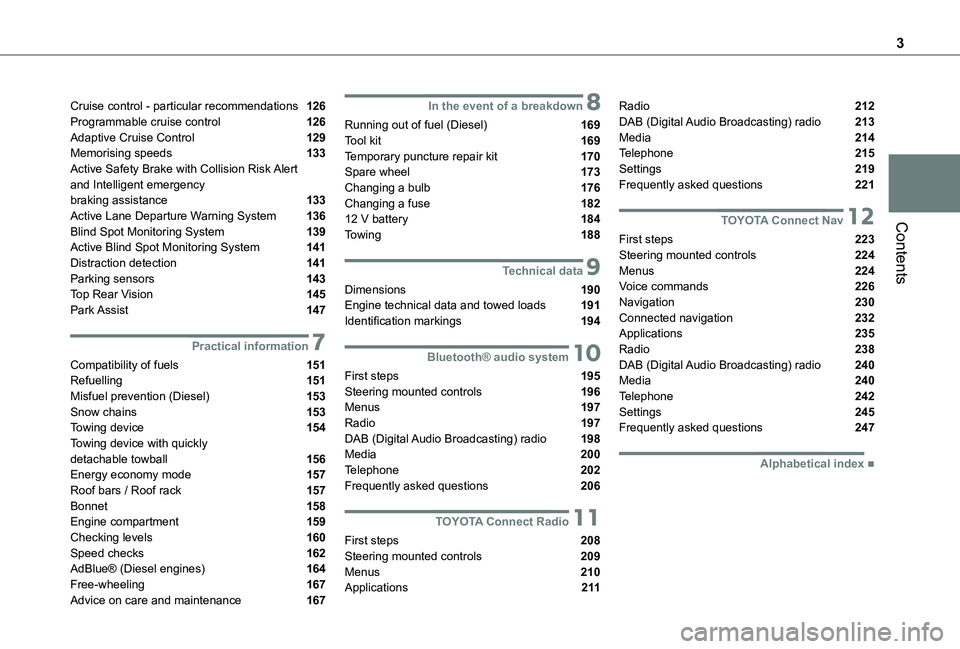
3
Contents
Cruise control - particular recommendations 126Programmable cruise control 126Adaptive Cruise Control 129Memorising speeds 133Active Safety Brake with Collision Risk Alert and Intelligent emergency braking assistance 133Active Lane Departure Warning System 136Blind Spot Monitoring System 139Active Blind Spot Monitoring System 141Distraction detection 141Parking sensors 143Top Rear Vision 145Park Assist 147
7Practical information
Compatibility of fuels 151Refuelling 151Misfuel prevention (Diesel) 153Snow chains 153Towing device 154Towing device with quickly
detachable towball 156Energy economy mode 157Roof bars / Roof rack 157Bonnet 158Engine compartment 159Checking levels 160Speed checks 162AdBlue® (Diesel engines) 164Free-wheeling 167
Advice on care and maintenance 167
8In the event of a breakdown
Running out of fuel (Diesel) 169Tool kit 169Temporary puncture repair kit 170Spare wheel 173Changing a bulb 176Changing a fuse 18212 V battery 184Towing 188
9Technical data
Dimensions 190Engine technical data and towed loads 191Identification markings 194
10Bluetooth® audio system
First steps 195Steering mounted controls 196Menus 197Radio 197DAB (Digital Audio Broadcasting) radio 198
Media 200Telephone 202Frequently asked questions 206
11TOYOTA Connect Radio
First steps 208Steering mounted controls 209Menus 210Applications 2 11
Radio 212DAB (Digital Audio Broadcasting) radio 213Media 214Telephone 215Settings 219Frequently asked questions 221
12TOYOTA Connect Nav
First steps 223Steering mounted controls 224Menus 224Voice commands 226Navigation 230Connected navigation 232Applications 235Radio 238DAB (Digital Audio Broadcasting) radio 240Media 240Telephone 242Settings 245Frequently asked questions 247
■Alphabetical index
Page 80 of 272
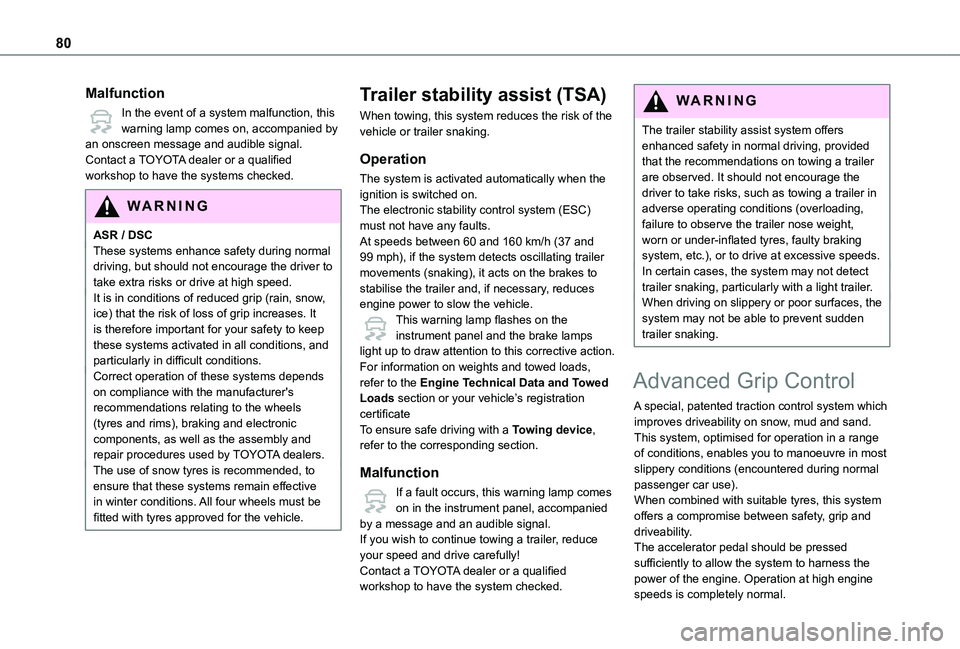
80
Malfunction
In the event of a system malfunction, this warning lamp comes on, accompanied by an onscreen message and audible signal.Contact a TOYOTA dealer or a qualified workshop to have the systems checked.
WARNI NG
ASR / DSCThese systems enhance safety during normal driving, but should not encourage the driver to take extra risks or drive at high speed.It is in conditions of reduced grip (rain, snow, ice) that the risk of loss of grip increases. It is therefore important for your safety to keep these systems activated in all conditions, and particularly in difficult conditions.Correct operation of these systems depends on compliance with the manufacturer's recommendations relating to the wheels (tyres and rims), braking and electronic components, as well as the assembly and
repair procedures used by TOYOTA dealers.The use of snow tyres is recommended, to ensure that these systems remain effective in winter conditions. All four wheels must be fitted with tyres approved for the vehicle.
Trailer stability assist (TSA)
When towing, this system reduces the risk of the vehicle or trailer snaking.
Operation
The system is activated automatically when the ignition is switched on.The electronic stability control system (ESC) must not have any faults.At speeds between 60 and 160 km/h (37 and 99 mph), if the system detects oscillating trailer movements (snaking), it acts on the brakes to stabilise the trailer and, if necessary, reduces engine power to slow the vehicle.This warning lamp flashes on the instrument panel and the brake lamps light up to draw attention to this corrective action.For information on weights and towed loads, refer to the Engine Technical Data and Towed Loads section or your vehicle’s registration certificateTo ensure safe driving with a Towing device,
refer to the corresponding section.
Malfunction
If a fault occurs, this warning lamp comes on in the instrument panel, accompanied by a message and an audible signal.If you wish to continue towing a trailer, reduce your speed and drive carefully!Contact a TOYOTA dealer or a qualified workshop to have the system checked.
WARNI NG
The trailer stability assist system offers enhanced safety in normal driving, provided that the recommendations on towing a trailer are observed. It should not encourage the driver to take risks, such as towing a trailer in adverse operating conditions (overloading, failure to observe the trailer nose weight, worn or under-inflated tyres, faulty braking system, etc.), or to drive at excessive speeds.In certain cases, the system may not detect trailer snaking, particularly with a light trailer.When driving on slippery or poor surfaces, the system may not be able to prevent sudden trailer snaking.
Advanced Grip Control
A special, patented traction control system which improves driveability on snow, mud and sand.This system, optimised for operation in a range
of conditions, enables you to manoeuvre in most slippery conditions (encountered during normal passenger car use).When combined with suitable tyres, this system offers a compromise between safety, grip and driveability.The accelerator pedal should be pressed sufficiently to allow the system to harness the power of the engine. Operation at high engine speeds is completely normal.
Page 154 of 272
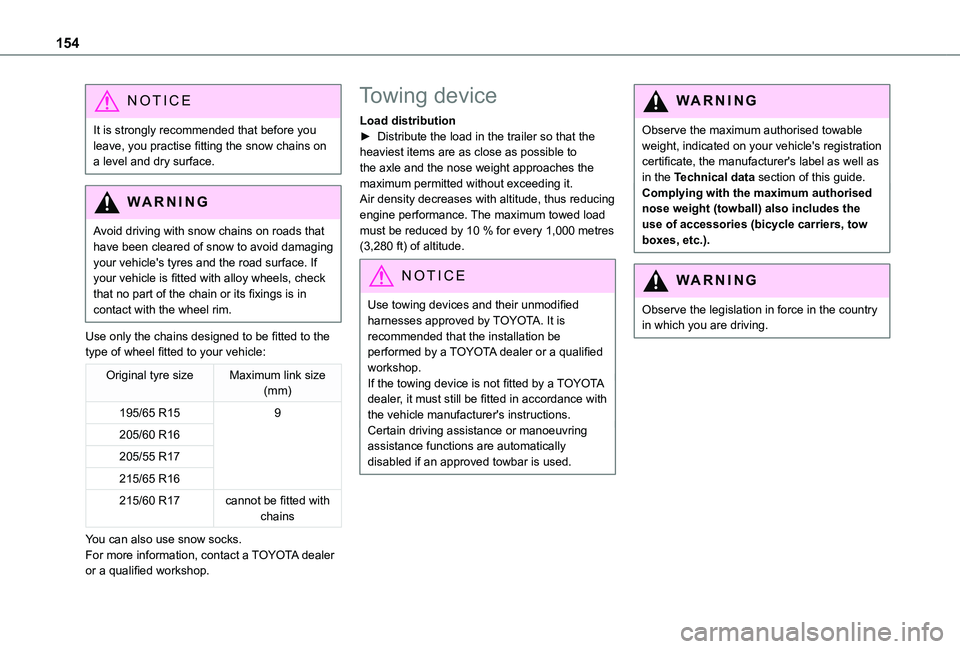
154
NOTIC E
It is strongly recommended that before you leave, you practise fitting the snow chains on a level and dry surface.
WARNI NG
Avoid driving with snow chains on roads that
have been cleared of snow to avoid damaging your vehicle's tyres and the road surface. If your vehicle is fitted with alloy wheels, check that no part of the chain or its fixings is in contact with the wheel rim.
Use only the chains designed to be fitted to the type of wheel fitted to your vehicle:
Original tyre sizeMaximum link size (mm)
195/65 R159
205/60 R16
205/55 R17
215/65 R16
215/60 R17cannot be fitted with chains
You can also use snow socks.For more information, contact a TOYOTA dealer or a qualified workshop.
Towing device
Load distribution► Distribute the load in the trailer so that the heaviest items are as close as possible to the axle and the nose weight approaches the maximum permitted without exceeding it.Air density decreases with altitude, thus reducing engine performance. The maximum towed load must be reduced by 10 % for every 1,000 metres (3,280 ft) of altitude.
NOTIC E
Use towing devices and their unmodified harnesses approved by TOYOTA. It is recommended that the installation be performed by a TOYOTA dealer or a qualified workshop.If the towing device is not fitted by a TOYOTA dealer, it must still be fitted in accordance with the vehicle manufacturer's instructions.Certain driving assistance or manoeuvring assistance functions are automatically disabled if an approved towbar is used.
WARNI NG
Observe the maximum authorised towable weight, indicated on your vehicle's registration certificate, the manufacturer's label as well as in the Technical data section of this guide.Complying with the maximum authorised nose weight (towball) also includes the use of accessories (bicycle carriers, tow boxes, etc.).
WARNI NG
Observe the legislation in force in the country in which you are driving.
Page 156 of 272
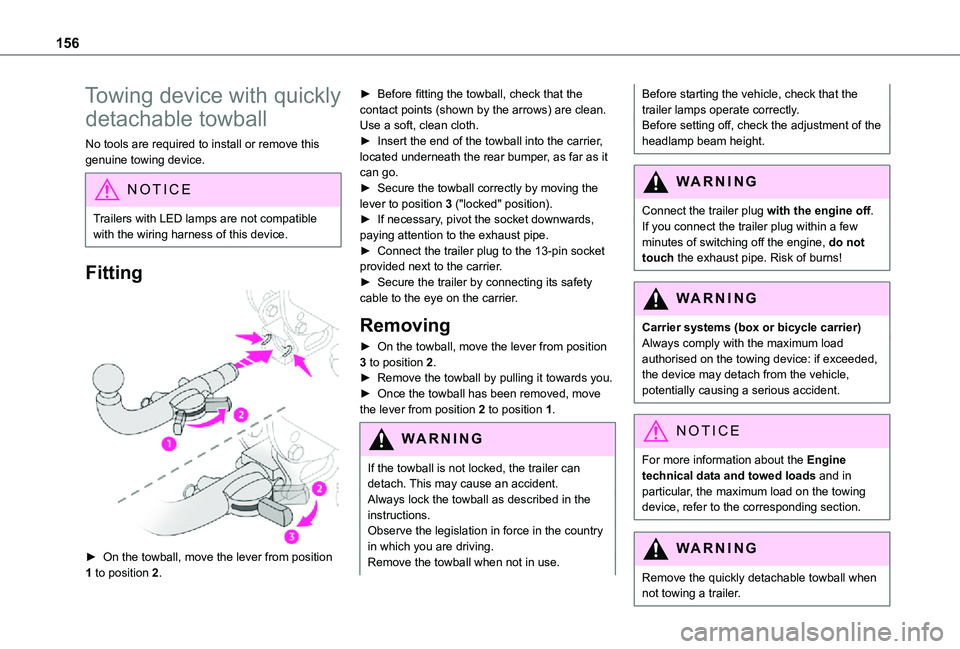
156
Towing device with quickly
detachable towball
No tools are required to install or remove this genuine towing device.
NOTIC E
Trailers with LED lamps are not compatible with the wiring harness of this device.
Fitting
► On the towball, move the lever from position 1 to position 2.
► Before fitting the towball, check that the contact points (shown by the arrows) are clean. Use a soft, clean cloth.► Insert the end of the towball into the carrier, located underneath the rear bumper, as far as it can go.► Secure the towball correctly by moving the lever to position 3 ("locked" position).► If necessary, pivot the socket downwards, paying attention to the exhaust pipe.► Connect the trailer plug to the 13-pin socket provided next to the carrier.► Secure the trailer by connecting its safety cable to the eye on the carrier.
Removing
► On the towball, move the lever from position 3 to position 2.► Remove the towball by pulling it towards you.► Once the towball has been removed, move the lever from position 2 to position 1.
WARNI NG
If the towball is not locked, the trailer can detach. This may cause an accident.Always lock the towball as described in the instructions.Observe the legislation in force in the country in which you are driving.Remove the towball when not in use.
Before starting the vehicle, check that the trailer lamps operate correctly.Before setting off, check the adjustment of the headlamp beam height.
WARNI NG
Connect the trailer plug with the engine off.If you connect the trailer plug within a few minutes of switching off the engine, do not
touch the exhaust pipe. Risk of burns!
WARNI NG
Carrier systems (box or bicycle carrier)Always comply with the maximum load authorised on the towing device: if exceeded, the device may detach from the vehicle, potentially causing a serious accident.
NOTIC E
For more information about the Engine technical data and towed loads and in particular, the maximum load on the towing device, refer to the corresponding section.
WARNI NG
Remove the quickly detachable towball when not towing a trailer.
Page 191 of 272
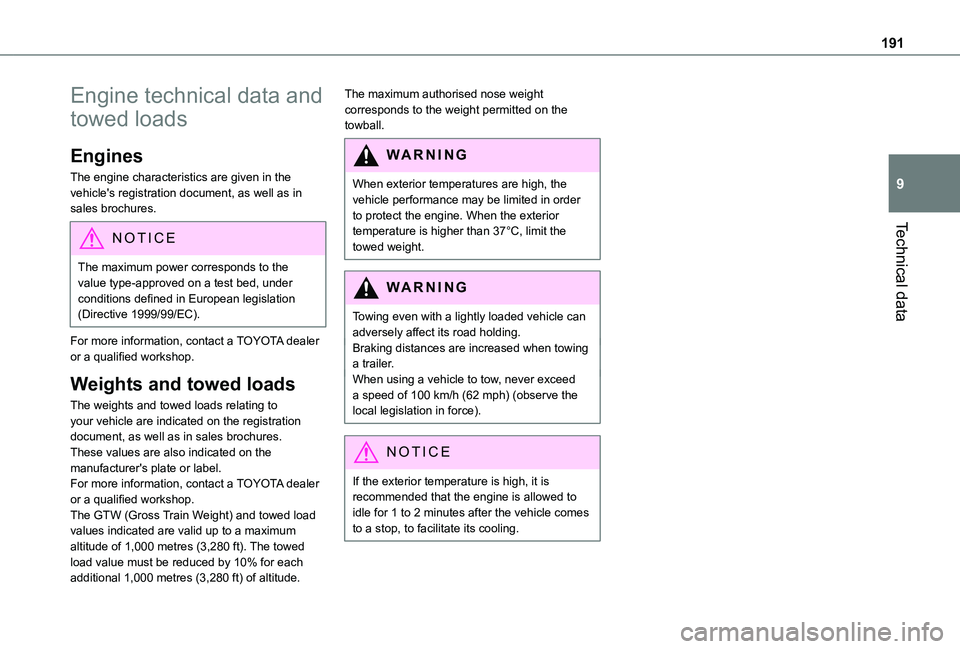
191
Technical data
9
Engine technical data and
towed loads
Engines
The engine characteristics are given in the vehicle's registration document, as well as in sales brochures.
NOTIC E
The maximum power corresponds to the value type-approved on a test bed, under conditions defined in European legislation (Directive 1999/99/EC).
For more information, contact a TOYOTA dealer or a qualified workshop.
Weights and towed loads
The weights and towed loads relating to your vehicle are indicated on the registration document, as well as in sales brochures.These values are also indicated on the manufacturer's plate or label.For more information, contact a TOYOTA dealer or a qualified workshop.The GTW (Gross Train Weight) and towed load values indicated are valid up to a maximum altitude of 1,000 metres (3,280 ft). The towed load value must be reduced by 10% for each additional 1,000 metres (3,280 ft) of altitude.
The maximum authorised nose weight corresponds to the weight permitted on the towball.
WARNI NG
When exterior temperatures are high, the vehicle performance may be limited in order to protect the engine. When the exterior temperature is higher than 37°C, limit the
towed weight.
WARNI NG
Towing even with a lightly loaded vehicle can adversely affect its road holding.Braking distances are increased when towing a trailer.When using a vehicle to tow, never exceed a speed of 100 km/h (62 mph) (observe the local legislation in force).
NOTIC E
If the exterior temperature is high, it is recommended that the engine is allowed to idle for 1 to 2 minutes after the vehicle comes to a stop, to facilitate its cooling.
Page 193 of 272
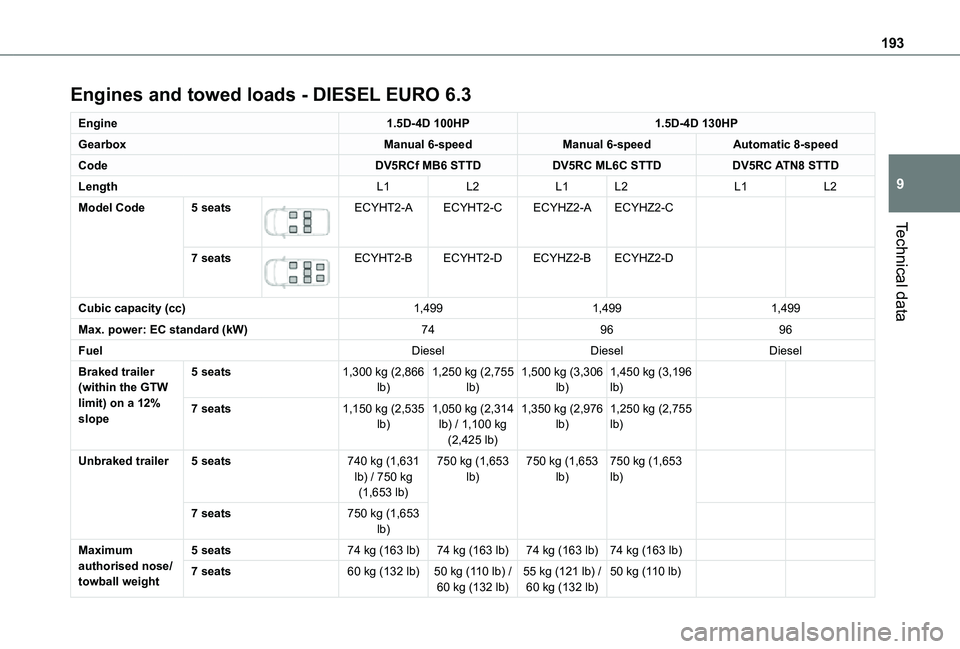
193
Technical data
9
Engines and towed loads - DIESEL EURO 6.3
Engine1.5D-4D 100HP1.5D-4D 130HP
GearboxManual 6-speedManual 6-speedAutomatic 8-speed
CodeDV5RCf MB6 STTDDV5RC ML6C STTDDV5RC ATN8 STTD
LengthL1L2L1L2L1L2
Model Code5 seats
ECYHT2-AECYHT2-CECYHZ2-AECYHZ2-C
7 seats
ECYHT2-BECYHT2-DECYHZ2-BECYHZ2-D
Cubic capacity (cc)1,4991,4991,499
Max. power: EC standard (kW)749696
FuelDieselDieselDiesel
Braked trailer (within the GTW limit) on a 12% slope
5 seats1,300 kg (2,866 lb)1,250 kg (2,755 lb)1,500 kg (3,306 lb)1,450 kg (3,196 lb)
7 seats1,150 kg (2,535 lb)1,050 kg (2,314 lb) / 1,100 kg (2,425 lb)
1,350 kg (2,976 lb)1,250 kg (2,755 lb)
Unbraked trailer5 seats740 kg (1,631 lb) / 750 kg (1,653 lb)
750 kg (1,653 lb)750 kg (1,653 lb)750 kg (1,653 lb)
7 seats750 kg (1,653 lb)
Maximum authorised nose/towball weight
5 seats74 kg (163 lb)74 kg (163 lb)74 kg (163 lb)74 kg (163 lb)
7 seats60 kg (132 lb)50 kg (110 lb) / 60 kg (132 lb)55 kg (121 lb) / 60 kg (132 lb)50 kg (110 lb)
Page 254 of 272

254
R
Radar (warnings) 11 9Radio 197–198, 212, 214, 238–239Radio, digital (Digital Audio Broadcasting - DAB) 198, 213, 240Range, AdBlue 162RDS 212, 239Rear screen, demisting 61Recharging the battery 186Recirculation, air 57–58Recovery 188Reduction of electrical load 157Regeneration of the particle filter 163Reinitialisation of the under-inflation detection system 11 7Reinitialising the remote control 30Reminder, key in ignition 104Reminder, lighting on 67Remote control 23–26, 28, 101Removing a wheel 174–176Removing the mat 48
Replacing bulbs 176–178Replacing fuses 182–184Replacing the air filter 163Replacing the oil filter 163Replacing the passenger compartment filter 162Reservoir, screenwash 161Reversing camera 11 9, 145–146Reversing lamps 180Roof 48
Roof bars 157–158Running out of fuel (Diesel) 169
S
Safety, children 86, 89–93, 96–98Saturation of the particle filter (Diesel) 163Screen menu map 216Screen, multifunction (with audio system) 197Screenwash, front 71Screenwash, rear 72SCR (Selective Catalytic Reduction) 164Seat belts 83–85, 92Seat, rear bench 44, 46Seats, front 39–41Seats, heated 42Seats, rear 39, 44–46, 90Sensors (warnings) 120Serial number, vehicle 194Service indicator 16Servicing 16, 162
Settings, system 219, 245Sidelamps 66, 68, 178–179Side parking sensors 144Side repeater 178Sliding side door, electric 27, 34Snow chains 11 6, 153–154Snow chains, link 154Socket, 12 V accessory 48–49Socket, 220 V 50Socket, auxiliary 201
Socket, Jack 201Speed limiter 123–126, 133Speed limit recognition 120, 122Speedometer 120Stability control (ESC) 78–81Starting a Diesel engine 151Starting the engine 101Starting the vehicle 102, 104, 11 0–11 3Starting using another battery 185Station, radio 197, 212, 238–239Stay, bonnet 159Steering mounted controls, audio 196, 209, 224Steering wheel, adjustment 42Stickers, customising ~ Stickers, expressive 168Stopping the vehicle 104, 11 0–11 3Stop & Start 22, 56, 60, 11 4–11 5, 151, 158, 162, 185, 187Storage 48Storage boxes 52Stowing rings 54Sunshine sensor 55
Switching off the engine 101, 103Synchronising the remote control 30
T
Tables of fuses 182–184Tank, fuel 151–153Technical data 192–193Telephone 51, 202–205, 217–219, 242–244